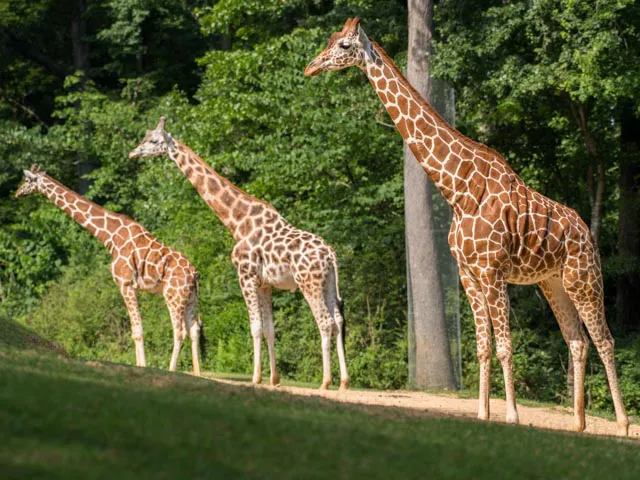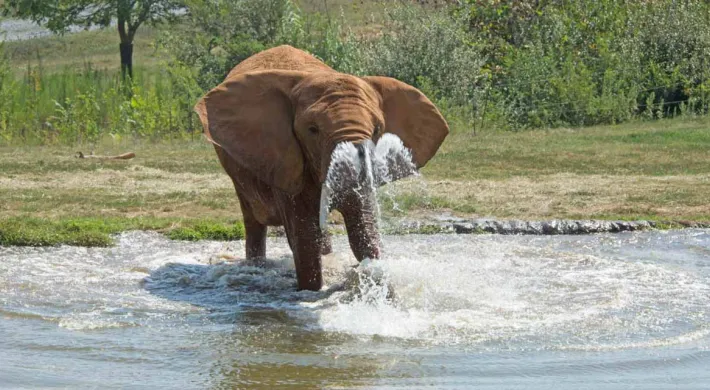Written by Camryn Jefferson, Student Researcher, North Carolina Zoo
My name is Camryn, and I study the giraffes here at the North Carolina Zoo! I am a graduating senior at North Carolina State University, majoring in Zoology and minoring in English. After graduation, I intend to pursue a career in wildlife conservation. As I work towards this goal, instead of a college class, I get credit through participating in research at the Zoo, which, in turn, will help me develop my skills as a scientist and animal behaviorist. For my study, I gather behavioral data on the giraffes to improve our understanding of their daily activities and, in the end, find ways to enhance their well-being.
Before I tell you about the work I am doing, first, let me tell you a bit about our giraffes!
Turbo is the oldest at 13 years (giraffes can live to be about 25 years old!). You can spot him by his teddy bear face or the "bat" spots on his neck. We have Jack, a northern giraffe, age 12, who is easy to identify because he is so much larger than the others with has irregular dark brown spots. Leia, a reticulated giraffe, age 11, is our adult female. Last but not least, we have baby Amelia. Amelia is 2.5 years old and has been with the Zoo for about a year now. Amelia is half the size of the rest of the giraffes, and she is the easiest to spot!
The most common question I get from guests is, "Why does that one giraffe look different than the rest?" That's because the Zoo houses three reticulated giraffes and 1 Northern giraffe – two different species of giraffe (Picture 1)!
Picture 1 Above: Jack (left), a Northern giraffe, and Turbo (right), a reticulated giraffe, represent different giraffe species!
As with all the animals, the NC Zoo's goal for the giraffes is to create a complex and stimulating environment designed to encourage behaviors seen in the wild, or "species-typical behaviors." While the foundation for understanding behavior starts at the species level, individuals vary in preferences, making it hard to create a "one size fits all" management plan. Scientific research is, therefore, necessary if we want to promote the well-being of each individual animal. The analysis allows us to study and understand the needs of the individual, allowing us to create management plans best suited for giraffes overall and helps us consider each individual giraffe.
To study the giraffe's behaviors, I watch the NC Zoo's group two days a week, for five hours at a time, and record their activities (resting, eating, walking, etc.) on a tablet. The giraffe habitat includes two primary areas: one visible to guests (Picture 2) and one "behind the scenes," which includes the giraffes' indoor habitat (i.e., barns). When it's too cold or wet, the giraffes stay behind the scenes to keep them safe from slipping, and the barn keeps them warm with heaters. I collect data from both locations because we want to make sure the giraffes are exhibiting healthy, happy behaviors everywhere they go!

Picture 2: Jack, Leia, and Turbo (right to left) enjoying their spacious outdoor habitat.
In addition to understanding the giraffe's behaviors, we are also interested in seeing if we can make changes to elicit a positive response and improve their well-being. For example, "enrichment" can be used as a tool to create a more challenging and stimulating environment. Enrichment can refer to any novelty, ranging from toys to an environmental change, such as a change in feeding schedules. For example, previous work at the Zoo has found that offering frozen mice as enrichment had positive effects on the behavior of our sand cats.
Because giraffes are natural grazers and spend a large part of their day feeding, most of their enrichment is feed-based. Keepers fill these specialized feeders with various foods, and the giraffe spent time manipulating the objects with their head, mouth, and even tongues to get the food out (Picture 3). The objective of this enrichment is to extend their foraging times and create a novel challenge. For example, the giraffes, and particularly Leia, love the parallax feeder, which is essentially a green sphere with small holes all over (Picture 4). The keepers can shove hay, lettuce, grain, or any other treat in these, making feeding a bit more challenging as giraffes have to move the ball around to get the food out. The giraffes love these enrichment items (because it means more food), AND they encourage desirable giraffe feeding behaviors — a win, win!

Picture 3: Leia using her tongue to forage for leaves. Giraffes rely on their long, prehensile tongue to feed on a variety of plants. We want to encourage this tongue use through various enrichment items.
For my project, based on what we know about giraffes generally and on what we know about individuals, we made two changes in the daily routine: 1) change grain feeds from two to three times per day, and 2) put hay in items that require some manipulation for them to extract. Both of these changes will increase their time spent foraging and create novelty in their day, all of which can improve giraffe well-being.

Picture 4: Leah with one of her favorite enrichment pieces: the parallax feeder.
Our next steps will be to collect more data and, in a few months, we will be able to tell if the enrichment use has increased feeding time and is associated with positive responses from our animals.
I'll leave you with a few of my favorite "gir-facts": they can weigh about 2,500 pounds, and their necks alone weigh between 500 and 600 pounds! Because of their large size and the need to efficiently pump blood throughout the body, their hearts can be up to two feet long and weigh up to 25 pounds!







